Sports—Japan's new growing industry
Recognizing sports as a key industry
The sports industry consists of three distinct segments: sports services and information, sports facilities, and sports gear.
Since 1990, these segments have merged, giving birth to a hybrid industry, and moreover have combined with other industries such as medicine, tourism, and fashion to create new business opportunities.
U.S. leads the industry. Need of Japan to catch up.
In 1995, the U.S. sports industry, in terms of market size, was worth 18.2 trillion yen, while Japan's was worth 5.7 trillion yen. By 2010, however, the U.S. market had grown rapidly to be worth about 50 trillion yen.
Once even worth more than the automotive industry, U.S. sports industry now has tripled over the past twenty years to 60 trillion yen.
On the contrary, the Japanese market is following a slightly downward trend. The U.S. market is now worth 12 times more than the Japanese market.
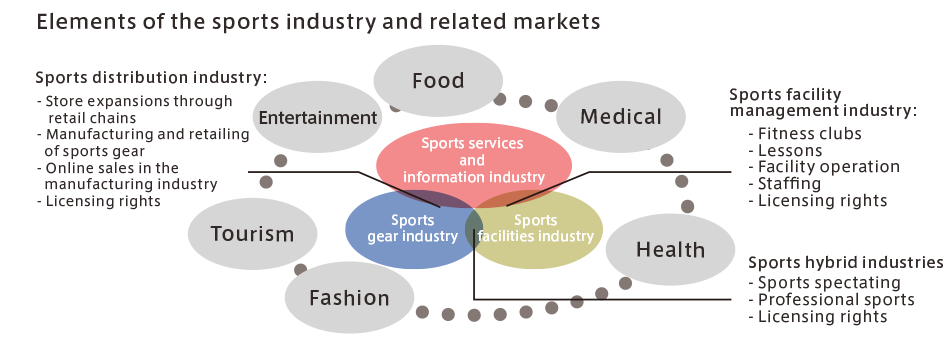
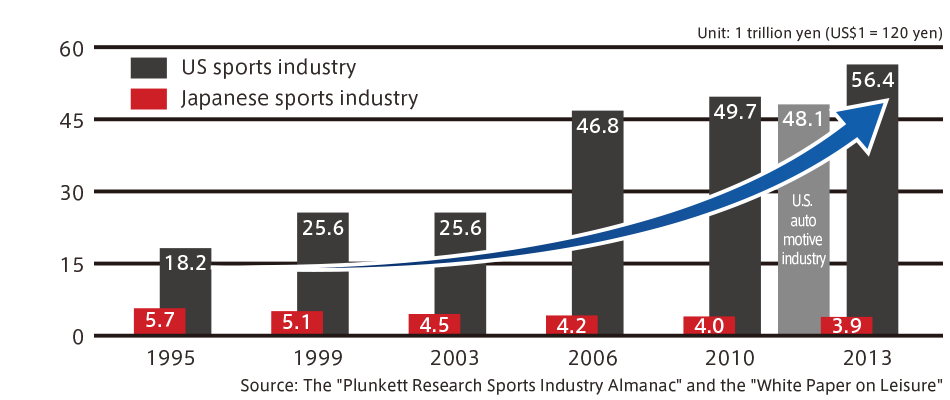
Enrich society through sports
 DOME was founded to deliver the change required for Japanese sports to catch up with the rest of the world. By changing the way we think, we can unleash the hidden potential of Japanese sports to transform them into a huge growth industry.
DOME was founded to deliver the change required for Japanese sports to catch up with the rest of the world. By changing the way we think, we can unleash the hidden potential of Japanese sports to transform them into a huge growth industry.
To realize its corporate mission of enriching society through sports, DOME will need to pursue the industrialization of Japanese sports. We are currently utilizing our businesses and assets to advance a variety of projects with the aim of generating world-class innovation in Japanese sports by drawing out and organically integrating the intrinsic benefits of sports, including their economic, educational, and health rewards.
DOME remains committed to enriching Japanese society by seeking to transform Japan through sports.
Innovation transforms sports into a profit center
Until around 1995, the U.S. and Japanese sports markets were in fairly similar situation. However, once sports were identified as a growth industry in the U.S., the public and private sectors began working together to industrialize sports. To this end, innovations were introduced in the following five areas.
1. Stadiums/arenas
More comprehensive hospitality was provided to optimize the customer experience.
2. Sports leagues/organizations
Organizational reforms were implemented to deliver more effective governance and create new revenue streams.
3. Media
The value of media coverage was boosted by transforming sports content into a profitable commodity.
4. Universities
Making sports teams the front porch of universities helped raise the overall profile of the universities, including the academic level.
5. Women's sports
The enactment of a federal law called Title IX helped boost women's participation in sports.
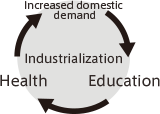 The tireless work to implement these innovations has helped to transform the sports industry into a profit center and strengthen U.S. sports culture.
The tireless work to implement these innovations has helped to transform the sports industry into a profit center and strengthen U.S. sports culture.
Without innovation, sport remains as a cost center
Japan remains caught up in the notion that sports are regarded as part of the education policy and an almost sacred undertaking that should not make profit. Consequently, some people feel that it is acceptable for sports to be a cost center, with taxes being spent to support it as a cultural activity.
Japan needs to recognize the intrinsic value of sports

Synergy between DOME and PLANTEC
 DOME's mission to enrich society through sports resonates strongly with the PLANTEC Group. As partners, we aim to leverage our full capabilities in order to provide solutions as well as advance and optimize the value of a variety of projects.
DOME's mission to enrich society through sports resonates strongly with the PLANTEC Group. As partners, we aim to leverage our full capabilities in order to provide solutions as well as advance and optimize the value of a variety of projects.
In this issue of the PLANTEC newsletter, we will describe five collaborations between DOME and PLANTEC.
Five case studies illustrating the efforts of DOME and PLANTEC to make sports into a growth industry


The evolution of sports facilities in the U.S.
Until the mid-1990s, most U.S. stadiums were located in suburban areas. Since then, however, aging stadiums and regional economic downturns have prompted a shift toward stadium and arenas relocation to central urban areas. Equipped with hotels and other commercial facilities and funded by public-private partnerships, these stadiums and arena complexes have been transformed into profit centers.
Many Japanese stadiums and arenas were originally built by local governments as athletic parks for the hosting of events such as the National Sports Festival. Offering poor transportation access, many of these facilities make a loss by failing to offer non-sporting events to attract people. Public funds support their running costs, making them cost centers.
The role of branding in determining the fate of stadiums and arenas
Japanese facilities tend to be owned by local governments, managed by a designated administrator, and leased by the home team.
In Western countries, however, many teams operate their own home stadium or arena. This allows them to operate their facilities with greater flexibility by, for example, carrying out renovations to optimize the customer experience. This, in turn, helps to increase profits.

Japanese stadiums and arenas must become all-inclusive sports entertainment facilities
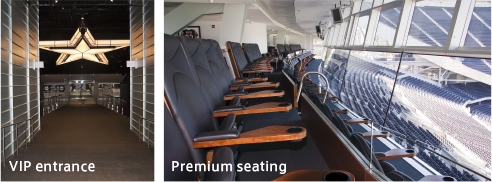 Moving forward, Japanese stadiums and arenas need to achieve three goals. The first is to optimize the customer experience by, for example, developing seating plans that ensure an exciting viewing experience and a feeling of being close to the action, establishing a unified facility concept, and introducing a design that ensures the seamless movement of people. The second is to establish areas that can be used for non-sporting events, such as concerts and conventions. The third is to secure reliable income streams by making full use of all of the space available, offering appealing food, beverages, merchandise, and VIP facilities that will attract visitors, and creating a commercial space where guests will spend money enjoying themselves.
Moving forward, Japanese stadiums and arenas need to achieve three goals. The first is to optimize the customer experience by, for example, developing seating plans that ensure an exciting viewing experience and a feeling of being close to the action, establishing a unified facility concept, and introducing a design that ensures the seamless movement of people. The second is to establish areas that can be used for non-sporting events, such as concerts and conventions. The third is to secure reliable income streams by making full use of all of the space available, offering appealing food, beverages, merchandise, and VIP facilities that will attract visitors, and creating a commercial space where guests will spend money enjoying themselves.

City development and integration of existing city functions centered on urban arenas
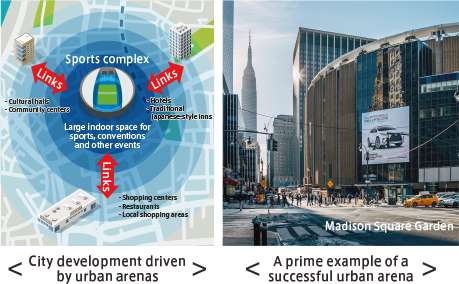 Urban stadiums and arenas are expected to attract people to cities and serve as hubs for city development. Driven by the private sector, arenas that are centrally located, have convenient access and are integrated with other attractions (e.g., convention centers, cultural halls and commercial facilities) will develop symbiotic relationships with existing facilities in the area and create ripple effects that contribute to city development.
Urban stadiums and arenas are expected to attract people to cities and serve as hubs for city development. Driven by the private sector, arenas that are centrally located, have convenient access and are integrated with other attractions (e.g., convention centers, cultural halls and commercial facilities) will develop symbiotic relationships with existing facilities in the area and create ripple effects that contribute to city development.
Having a local sports team and increased opportunities to watch and play sports will increase the affection that local residents have for the area. Furthermore, a stadium or arena can increase a region's appeal by becoming a symbol of the area.
Situated directly above Penn Station, Madison Square Garden is a centrally located urban arena that attracts numerous sporting events and concerts every year. Home to a cinema, a theater, and conference facilities as well, it attracts crowds from around the U.S. and the rest of the world as a Manhattan landmark, making it a core element of city development and a contributor to local employment.
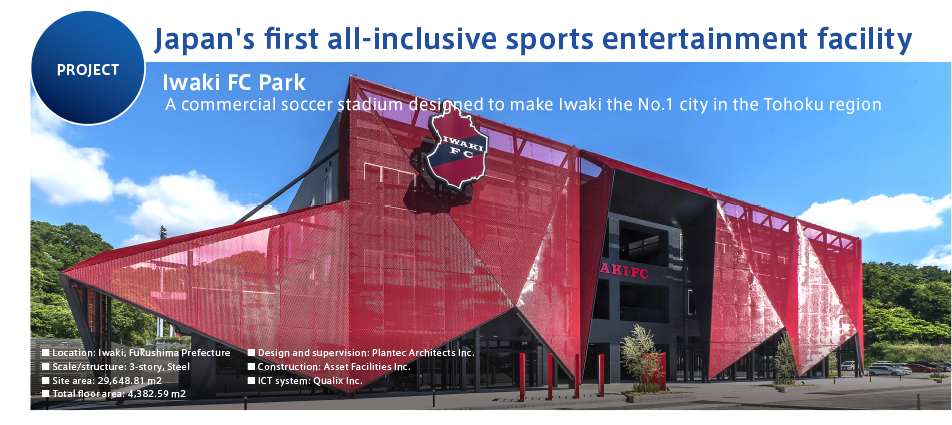
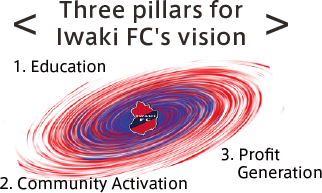 This stadium was built as the club house ground for Iwaki FC based on a vision of making Iwaki the No.1 city in the Tohoku region through sports.
This stadium was built as the club house ground for Iwaki FC based on a vision of making Iwaki the No.1 city in the Tohoku region through sports.
Through its expansion and renovation, this former office building has been transformed into a facility that serves as not only the team's club house, but also Japan's first multipurpose soccer stadium to feature unique commercial offerings, such as an Under Armour store and restaurants. By attracting visitors beyond just sports fans, the facility is able to generate revenue while strengthening the team and helping to revitalize the region, thereby boosting the brand value of Iwaki City.
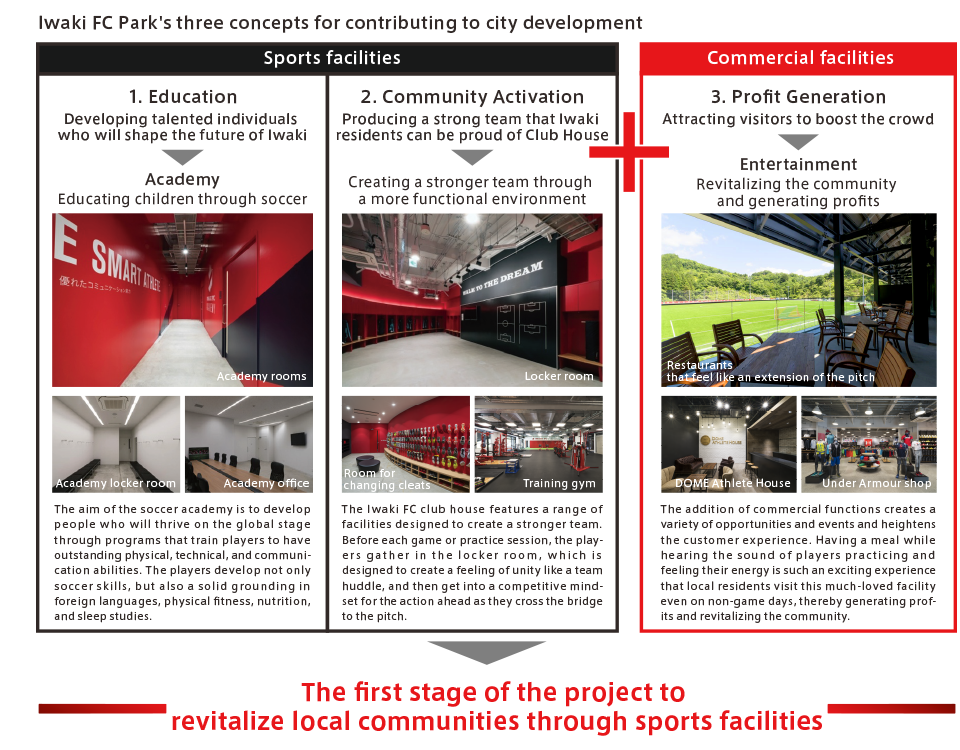

The importance of the environment and branding in college sports
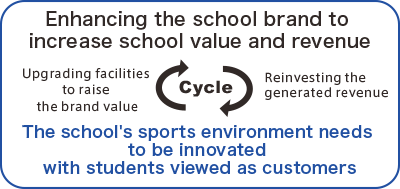 With sports teams often considered to be the front porch of universities in the U.S., athletic departments oversee the various sports programs that they offer. Team uniforms, colors, and logos are unified to promote school branding through sports, while the educational environment is improved to attract students and strengthen the teams. All of this helps to generate new revenue.
With sports teams often considered to be the front porch of universities in the U.S., athletic departments oversee the various sports programs that they offer. Team uniforms, colors, and logos are unified to promote school branding through sports, while the educational environment is improved to attract students and strengthen the teams. All of this helps to generate new revenue.
Japanese universities must follow this pattern by proactively working to innovate their approach to collegiate sports.
Approaches to collegiate sports in Japan and the U.S.



The first step in school branding
Hosei University's American football club house
A project for the renovation of the club house interior has been launched.
The design is aimed at creating an environment that meets student expectations and contributes to enhancing the school's brand. The space features three key elements for branding: excitement, exceptional functionality, and cleanliness.
Viewing students as customers to improve the sports environment
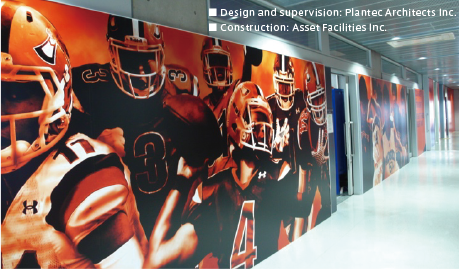
Creating a hybrid facility that will nurture the futures of young dreamers
Under Armour Baseball House Kawasaki
Educational and commercial features were added as part of a renovation project for an indoor batting cage facility to create a comprehensive facility that helps children to grow and develop through baseball.
An after-school meeting point, this facility serves not only as an educational space where children can interact with adults, but also as a commercial space filled with wow factors.
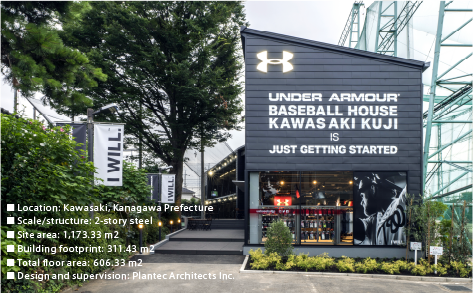
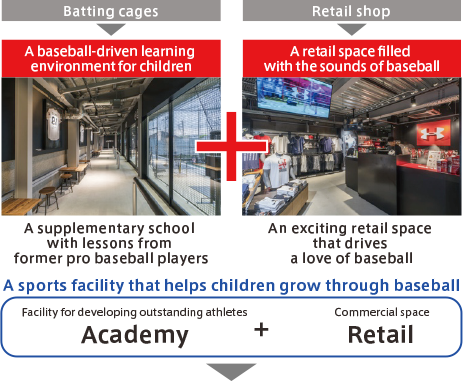
A new form of retail space that can't be achieved by conventional fast fashion
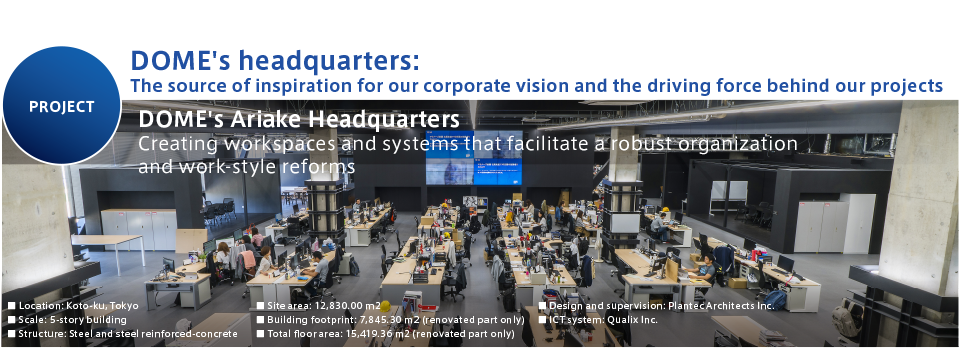
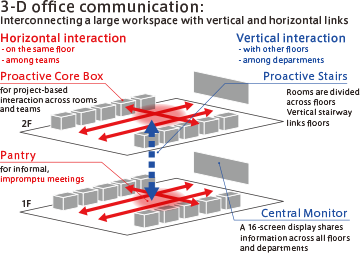 At DOME, all staff have access to and can collaboratively update the same information at any time no matter where they are. DOME has achieved this by transitioning to a matrix-style organizational structure in which horizontal links known as "units" and "projects" are incorporated into a vertical organizational structure. In line with this management approach, we have created an office space that is functional and appealing to all.
At DOME, all staff have access to and can collaboratively update the same information at any time no matter where they are. DOME has achieved this by transitioning to a matrix-style organizational structure in which horizontal links known as "units" and "projects" are incorporated into a vertical organizational structure. In line with this management approach, we have created an office space that is functional and appealing to all.

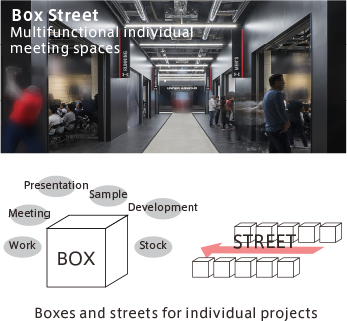 The "proactive matrix" concept frees the organization from the traditional silo structure by creating horizontal ties. To facilitate this working style, we created separate workspaces for each project in addition to the standard work desks. With these boxes lined up along a "street," the progress status for each project is immediately obvious to anyone passing by. This improves organizational agility by promoting organic communication and fostering a creative office environment.
The "proactive matrix" concept frees the organization from the traditional silo structure by creating horizontal ties. To facilitate this working style, we created separate workspaces for each project in addition to the standard work desks. With these boxes lined up along a "street," the progress status for each project is immediately obvious to anyone passing by. This improves organizational agility by promoting organic communication and fostering a creative office environment.
Organizational structure in Ariake HQ to progress projects with a unified perspective.


 In pursuit of adopting a workstyle and environment where our employees can work 24/7—whether they be in bed, at work or somewhere relaxing—we have created workspaces that function as both a combat zone that facilitates high-stakes work and a resort zone that provides the rest and relaxation necessary to jump back into the fray.
In pursuit of adopting a workstyle and environment where our employees can work 24/7—whether they be in bed, at work or somewhere relaxing—we have created workspaces that function as both a combat zone that facilitates high-stakes work and a resort zone that provides the rest and relaxation necessary to jump back into the fray.
Our efforts are aimed at realizing work-life integration that offers agility and flexibility.

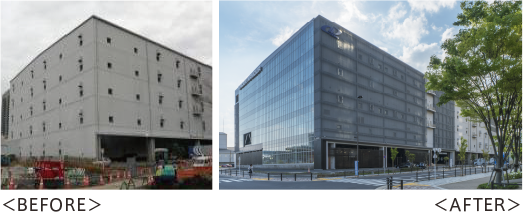 By converting a warehouse into an office, we maximized the advantages of the existing architecture by renovating it to add new value. Its high ceilings and large, open spaces allowed us to explore new possibilities for office space utilization without being constrained by preconceived ideas.
By converting a warehouse into an office, we maximized the advantages of the existing architecture by renovating it to add new value. Its high ceilings and large, open spaces allowed us to explore new possibilities for office space utilization without being constrained by preconceived ideas.
We renovated the building's exterior in line with the area's transition from a warehouse district to a waterfront site. The building now serves as a central hub for the promotion of sports in Koto-ku, an area in which several Olympic facilities will be located.
Incorporating all of the functions that a dynamic sports brand requires, this facility will provide the central impetus for the sports-driven development of the area.

